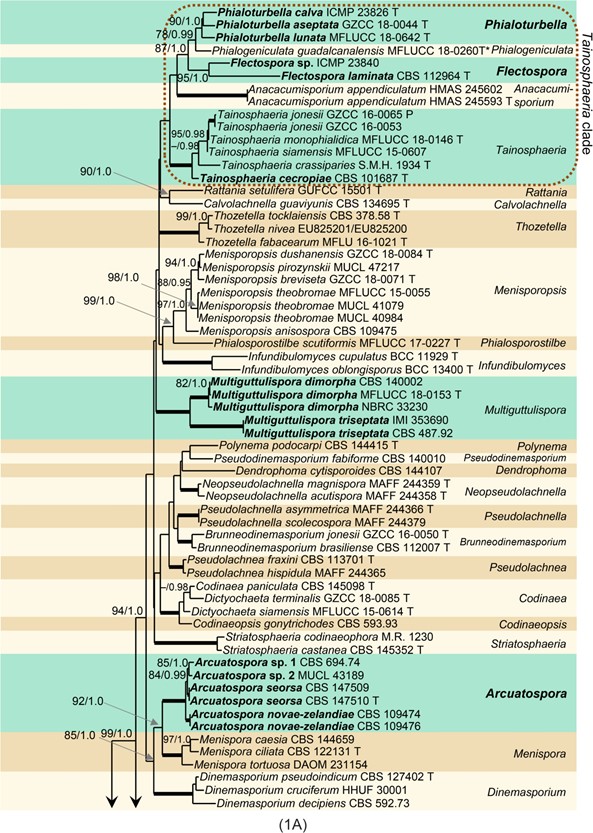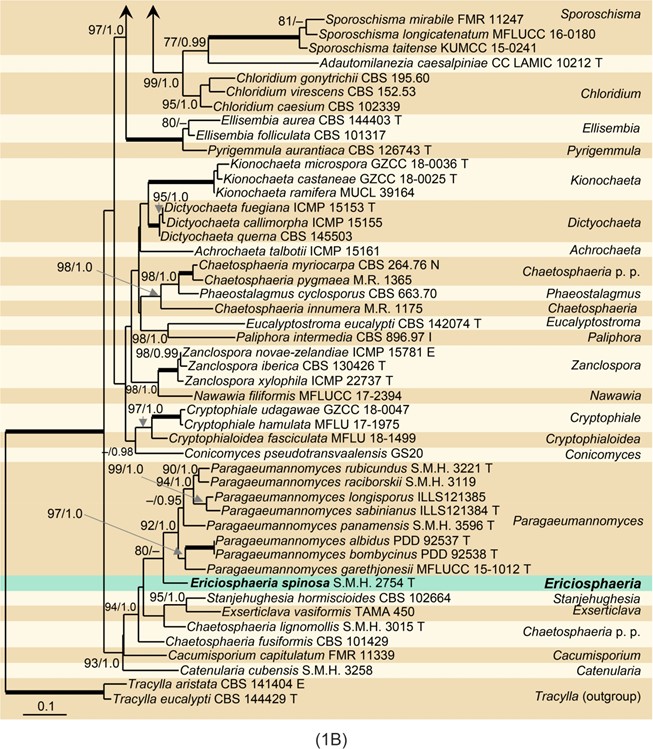Phialoturbella Réblová & Hern.-Restr., in Réblová, Nekvindová & Hernández-Restrepo, Journal of Fungi 7(6, no. 438): 27 (2021)
MycoBank number: MB 839483; Index Fungorum number: IF 839483; Facesoffungi number: FoF14619;
Etymology – Phiale (L), a broad, flat vessel referring to a phialidic conidiogenous cells, turbella (L), a little crowd, diminutive of turba, referring to crowded conidiophores.
Type species – Phialoturbella lunata (Z.L. Luo, K.D. Hyde & H.Y. Su) Réblová & Hern.-Restr.
Description – Colonies on the natural substrate effuse, hairy, mycelium partly superficial, partly immersed, hyphae brown, composed of conidiophores, occasionally ascomata. Asexual morph: Setae absent. Conidiophores macronematous, mononematous, single or arise in groups from dark stromatic cells, unbranched, erect, straight or flexuous, septate, smooth, brown. Conidiogenous cells integrated, terminal, mono- or polyphialidic, extending percurrently and sympodially, cylindrical, pale brown, subhyaline towards the apex; collarettes funnel-shaped. Macroconidia falcate, lunate or oblong and curved, slightly truncate at the basal hilum, hyaline, aseptate, without setulae, accumulate in slimy fascicles. Microconidia (observed only in culture) falcate, lunate or oblong-clavate, curved, truncate at the basal hilum, hyaline, aseptate, without setulae, formed from the same conidiogenous loci. Sexual morph: Ascomata perithecial, non-stromatic, superficial, sub-globose to conical, papillate or with a beak-like neck, dark brown, glabrous. Ostiole periphysate. Ascomatal wall two-layered, carbonaceous. Paraphyses persistent, septate, hyaline. Asci unitunicate, cylindrical-clavate, sessile or with a short stipe, ascal apex with a non-amyloid apical annulus, 8-spored. Ascospores ellipsoidal, hyaline, aseptate, smooth.
Habitat and geographical distribution – Saprobes on decaying bark and wood, known in China and New Zealand ([2,15], this study).
Note – Tainosphaeria [3] grouped into three lineages in the ITS-28S phylogenetic tree (Figure 1). Tainosphaeria crassiparies and four other species clustered in a monophyletic clade and represent the core of the genus characterised by macronematous, solitary, simple conidiophores, usually monophialidic conidiogenous cells and falcate, setulate conidia. However, three Tainosphaeria species were not resolved congeneric with T. crassiparies. Tainosphaeria aseptata, T. lunata, and a morphologically similar strain ICMP 23826 from New Zealand, clustered as a separate lineage, introduced as the new genus Phialoturbella (Ph.). This is characterised by macronematous, solitary or crowded, simple conidiophores with mono- occasionally polyphialidic conidiogenous cells and aseptate, falcate to lunate conidia without setulae. Tainosphaeria obclavata is transferred to Phialogeniculata; for a discussion see above. Several morphologically similar species of Dictyochaeta can be considered relatives or possible candidates for inclusion in Phialoturbella, namely D. apiculata [71], D. botulispora [9], D. heteroderae [82], D. illinoensis [83] and D. occidentalis [84]. Unfortunately, none of these species has available DNA sequences or cultures. Recollecting these taxa and obtaining axenic cultures and DNA data is necessary to resolve this little-known complex of species.

Figure 1. Cont.

Figure 1. (A) Phylogenetic tree based on the combined ITS-28S rDNA sequences constructed by maximum likelihood (RAxML) of selected members of the Chaetosphaeriaceae. Species names given in bold and placed in green boxes are taxonomic novelties. T, E, I, N and P indicate ex-type, ex-epitype, ex-isotype, ex-neotype and ex-paratype strains; asterisk (*) indicates ex-type of Tainosphaeria obclavata (=Phialogeniculata guadalcanalensis). Thickened branches indicate branch support with ML BS = 100% and PP values = 1.0. Branch support of nodes ≥ 75% ML and ≥0.95 PP is indicated above or below branches. (B) Phylogenetic tree based on the combined ITS-28S rDNA sequences of the Chaetosphaeriaceae (continued). For legend refer to (A). Abbreviation: p.p. after a genus name (pro parte).
